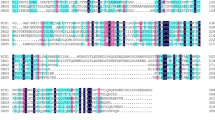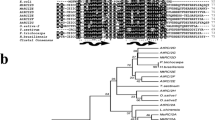Abstract
Two closely related, tandemly arranged, low-temperature- and salt-induced Arabidopsis genes, corresponding to the previously isolated cDNAs RCI2A and RCI2B, were isolated and characterized. The RCI2A transcript accumulated primarily in response to low temperature or high salinity, and to a lesser extent in response to ABA treatment or water deficit stress. The RCI2B transcript was present at much lower levels than RCI2A, and could only be detected by reverse transcription-PCR amplification. The predicted 6 kDa RCI2 proteins are highly hydrophobic and contain two putative membrane-spanning regions. The polypeptides exhibit extensive similarity to deduced low-temperature- and/or salt-induced proteins from barley, wheat grass and strawberry, and to predicted proteins from bacteria, fungi, nematodes and yeast. Interestingly, we found that a deletion of the RCI2 homologous gene, SNA1 (YRD276c), in yeast causes a salt-sensitive phenotype. This effect is specific for sodium, since no growth defect was observed for the sna1 mutant on 1.7 M sorbitol, 1 M KCl or 0.6 M LiCl. Finally, we found that the Arabidopsis RCI2A cDNA can complement the sna1 mutant when expressed in yeast, indicating that the plant and yeast proteins have similar functions during high salt stress.
Similar content being viewed by others
References
Arora, R. and Palta, J.P. 1991. A loss in the plasma membrane ATPase activity and its recovery coincides with incipient freeze-thaw injury and post-thaw recovery in onion bulb scale tissue. Plant Physiol. 95: 846–852.
Baker, S.S., Wilhelm, K.S. and Thomashow, M.F. 1994. The 5′-region of Arabidopsis thaliana cor15a has cis-acting elements that confer cold-, drought-and ABA-regulated gene expression. Plant Mol. Biol. 24: 701–713.
Bonneaud, N., Ozier-Kalogeropoulos, O., Li G.Y., Labouesse, M., Minvielle-Sebastia, L. and Lacroute, F. 1991. A family of low and high copy replicative, integrative and single-stranded S. cerevisiae/E. coli shuttle vectors. Yeast 7: 609–615.
Bray, E.A. 1997. Plant responses to water deficit. Trends Plant Sci. 2: 48–54.
Capel, J., Jarillo, J.A., Salinas, J. and Martinez-Zapater, J.M. 1997. Two homologous low-temperature-inducible genes from Arabidopsis encode highly hydrophobic proteins. Plant Physiol. 115: 569–576
Chen, H.H., Li, P.H. and Brenner, M.L. 1983. Involvement of abscisic acid in potato cold acclimation. Plant Physiol. 71: 362–365.
Dunn, M.A., Goddard, N.J., Zhang, L., Pearce, R.S. and Hughes, M.A. 1994. Low-temperature-responsive barley genes have different control mechanisms. Plant Mol. Biol. 24: 879–888.
Entian, K.-D. and Kötter, P. 1998. Yeast mutants and plasmid collections. Meth. Microbiol. 26: 431–449.
Espinosa-Ruiz, A., Belles, J.M., Serrano, R. and Culianez-MacIa, F.A. 1999. Arabidopsis thaliana AtHAL3: a flavoprotein related to salt and osmotic tolerance and plant growth. Plant J. 20: 529–539.
Ferrando, A., Kron, S.J., Rios, G., Fink, G.R. and Serrano, R. 1995. Regulation of cation transport in Saccharomyces cerevisiae by the salt tolerance gene HAL3. Mol. Cell Biol. 15: 5470–5481.
Gaxiola, R.A., Rao, R., Sherman, A., Grisafi, P., Alper, S.L. and Fink, G.R. 1999. The Arabidopsis thaliana proton transporters, AtNhx1 and Avp1, can function in cation detoxification in yeast. Proc. Natl. Acad. Sci. USA 96: 1480–1485.
Goddard, N.J., Dunn, M.A., Zhang, L., White, A.J., Jack, P.L. and Hughes, M.A 1993. Molecular analysis and spatial expression pattern of a low-temperature-specific barley gene, blt101.Plant Mol. Biol. 23: 871–879.
Gulick, P.J., Shen, W. and Hongyan, A. 1994. ESI3, a stress-induced gene from Lophopyrum elongatum. Plant Physiol. 104: 799–800.
Hanks, S.K., Quinn, A.M. and Krebs, E.G. 1988. The protein kinase family: conserved features and deduced phylogeny of the catalytic domains. Science 241: 42–52.
Haro, R., Garciadeblas, B. and Rodríguez-Navarro, A. 1991. A novel P-type ATPase from yeast involved in sodium transport. FEBS Lett. 291: 189–191.
Haro, R., Bañuelos, M.A., Quintero, F.J., Rubio, F. and Rodríguez-Navarro, A. 1993. Genetic basis of sodium exclusion and sodium tolerance in yeast. A model for plants. Physiol. Plant. 89: 868–874.
Heino, P., Sandman, G., Lång, V., Nordin, K. and Palva, E.T. 1990. Abscisic acid deficiency prevents development of freezing tolerance in Arabidopsis thaliana (L.) Heynh. Theor. Appl. Genet. 79: 801–806.
Hughes, M.A. and Dunn, M.A. 1996. The molecular biology of plant acclimation to low temperature. J. Exp. Bot. 47: 291–305.
Iswari, S. and Palta, J.P. 1989. Plasma membrane ATPase activity following reversible and irreversible freezing injury. Plant Physiol. 90: 1088–1095.
Koornneef, M., Jorna, M.L., Brinkhorst-van der Swan, D.L.C. and Karssen, C.M. 1982. The isolation of abscisic acid (ABA) deficient mutants by selection of induced revertants in non-germinating gibberellin sensitive lines of Arabidopsis thaliana (L.) Heynh. Theor. Appl. Genet. 61: 385–393.
Koornneef, M., Reuling, G. and Karssen, C.M. 1984. The isolation and characterization of abscisic acid insensitive mutants of Arabidopsis thaliana. Physiol. Plant 61: 377–383.
Kudla, J., Xu, Q., Harter, K., Gruissem, W. and Luan, S. 1999. Genes for calcineurin B-like protein in Arabidopsis are differentially regulated by stress signals. Proc. Natl. Acad. Sci. USA 96: 4718–4723.
Lång, V., Heino, P. and Palva, E.T. 1989. Low temperature acclimation and treatment with exogenous abscisic acid induce common polypeptides in Arabidopsis thaliana (L.) Heynh. Theor. Appl. Genet. 77: 729–734.
Lång, V., Mäntylä, E., Welin, B., Sundberg, B., Palva, E.T. 1994. Alterations of water status, endogenous abscisic acid content, and expression of rab18 gene during the development of freezing tolerance in Arabidopsis thaliana. Plant Physiol. 104: 1341–1349.
Lewitt, J. 1980. Responses of Plants to Environmental Stresses, vol. 2. Chilling, Freezing and High Temperature Stresses. Academic Press, New York.
Liang, P. and Pardee, A.B. 1992. Differential display of eukaryotic messenger RNA by means of the polymerase chain reaction. Science 257: 967–971.
Mäntylä, E., Lång, V. and Palva, E.T. 1995. Role of abscisic acid in drought-induced freezing tolerance, cold acclimation and accumulation of LTI78 and RAB18 proteins in Arabidopsis thaliana. Plant Physiol. 107: 141–148.
Mendizabal, I., Rios, G., Mulet, J.M., Serrano, R. and de Larrinoa, I.F. 1998. Yeast putative transcription factors involved in salt tolerance. FEBS Lett. 425: 323–328.
Mendoza, I., Rubio, F., Rodriguez-Navarro, A. and Pardo, J.M. 1994. The protein phosphatase calcineurin is essential for NaCl tolerance of Saccharomyces cerevisiae. Proc. Natl. Acad. Sci.USA 269: 8792–8796.
Mulet, J.M., Leube, M.P., Kron, S.J., Rios, G., Fink, G.R. and Serrano, R. 1999. A novel mechanism of ion homeostasis and salt tolerance in yeast: the Hal4 and Hal5 protein kinases modulate the Trk1-Trk2 potassium transporter. Mol. Cell Biol. 19: 3328–3337.
Navarre, C. and Goffeau, A. 2000. Membrane hyperpolarization and salt sensitivity induced by deletion of PMP3, a highly conserved small protein of yeast plasma membrane. EMBO J. 19: 2515–2524.
NDong, C., Ouellet, F., Houde, M. and Sarhan, F. 1997. Gene expression during cold acclimation in strawberry. Plant Cell Physiol. 38: 863–870.
Niu, X., Bressan, R.A., Hasegawa, P.M. and Pardo, J.M. 1995. Ion homeostasis in NaCl environments. Plant Physiol. 109: 735–742.
Nordin, K., Vahala, T. and Palva, E.T. 1993. Differential expression of two related, low-temperature-induced genes in Arabidopsis thaliana (L.) Heynh. Plant Mol. Biol. 21: 641–653.
Oren-Shamir, M., Pick, U. and Avron, M. 1989. Involvement of the plasma membrane ATPase in the osmoregulatory mechanism of the alga Dunaliella salina. Plant Physiol. 89: 1258–1263.
Palta, J.P. and Weiss, L.S. 1993. Ice formation and freezing injury: an overview on the survival mechanisms and molecular aspects of injury and cold acclimation in herbaceous plants. In: P.H. Li and L. Christersson, L. (Eds.) Advances in Plant Cold Hardiness, CRC Press, Boca Raton, FL, pp.143–176.
Palva, E.T. 1994. Gene expression under low temperature stress. In: A.S. Basra (Ed.) Stress Induced Gene Expression in Plants, Harwood Academic Publishers, pp. 103–113.
Pearce, R.S., Houlston, C.E., Atherton, K.M., Rixon, J.E., Harrison, P., Hughes, M.A. and Dunn, M.A. 1998. Localization of expression of three cold-induced genes, blt101, blt4.9,and blt14, in different tissues of the crown and developing leaves of cold-acclimated cultivated barley. Plant Physiol. 117: 787–795
Rodríguez-Navarro, A. and Ramos, J. 1984. Dual system for potassium transport in Saccharomyces cerevisiae. J. Bact. 159: 940–945.
Ryu, S.B., Costa, A., Xin, Z. and Li, P.H. 1995. Induction of cold hardiness by salt involves synthesis of cold-and abscisic acid-responsive proteins in potato (Solanum commersonii Dun). Plant Cell Physiol. 36: 1245–1251.
Sakai, A. and Larcher, W. 1987. Frost Survival of Plants: Responses and Adaptation to Freezing Stress. Springer-Verlag, Berlin.
Saitou, N. and Nei, M. 1987. The neighbor-joining method: a new method for reconstructing phylogenetic trees. Mol. Biol. Evol. 4: 406–425.
Schmidt, J.E., Schmitt, J.M., Kaiser, W.M. and Hincha, D.K. 1986. Salt treatment induces frost hardiness in leaves and isolated thylakoids from spinach. Planta 168: 50–55.
Sherman, F., Fink, G.R. and Hicks, J.B. 1986. Methods in Yeastai Genetics. Cold Spring Harbor Laboratory Press, Plainview, NY.
Thomashow, M.F. 1998. Role of cold-responsive genes in plant freezing tolerance. Plant Physiol. 118: 1–7.
Thompson, J.D., Gibson, T.J., Plewniak, F., Jeanmougin, F. and Higgins, D.G. 1997. The CLUSTAL-X windows interface: flexible strategies for multiple sequence alignment aided by quality analysis tools. Nucl. Acids Res. 24: 4876–4882.
Urao, T., Yakubov, B., Satoh, R., Yamaguchi-Shinozaki, K., Seki, M., Hirayama, T. and Shinozaki, K. 1999. A transmembrane hybrid-type histidine kinase in Arabidopsis functions as an osmosensor. Plant Cell 11: 1743–1754.
van West, P., Kamoun, S., van't Klooster, J.W. and Govers, F. 1999. Ric1, aPhytophthora infestans gene with homology to stress-induced genes. Curr. Genet. 36: 310–315.
Varela, J.C.S. and Mager, W.H. 1996. Responses of Saccharomyces cerevisiae to changes in external osmolarity. Microbiology 142: 721–731.
Verwoerd, T.C., Dekker, B.M.M. and Hoekema, A. 1989. A small scale procedure for the rapid isolation of plant RNAs. Nucl. Acids Res.17: 2362.
Yamaguchi-Shinozaki, K. and Shinozaki, K. 1994. A novel cis-acting element in an Arabidopsis gene is involved in responsiveness to drought, low-temperature, or high-salt stress. Plant Cell 6: 251–264.
Yeo, A. 1998. Molecular biology of salt tolerance in the context of whole-plant physiology. J. Exp. Bot. 49: 915–929.
Author information
Authors and Affiliations
Rights and permissions
About this article
Cite this article
Nylander, M., Heino, P., Helenius, E. et al. The low-temperature- and salt-induced RCI2A gene of Arabidopsis complements the sodium sensitivity caused by a deletion of the homologous yeast gene SNA1. Plant Mol Biol 45, 341–352 (2001). https://doi.org/10.1023/A:1006451914231
Issue Date:
DOI: https://doi.org/10.1023/A:1006451914231




